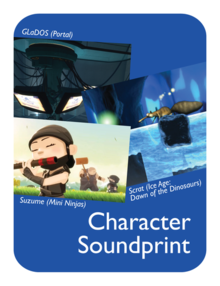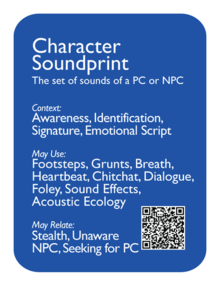Difference between revisions of "Character Soundprint"
ValterAlves (Talk | contribs) m |
ValterAlves (Talk | contribs) m |
||
| Line 27: | Line 27: | ||
: Also characters usually express themselves through a language which may be actual [[Dialogue]] and/or more basic utterances (e.g. [[Shout and Yell]] or even simpler [[Grunts]]). | : Also characters usually express themselves through a language which may be actual [[Dialogue]] and/or more basic utterances (e.g. [[Shout and Yell]] or even simpler [[Grunts]]). | ||
| − | + | *Then, [[Character Soundprint]] may also be relevant in terms of [[Identification]], there is to provide the means for the player to be able to distinguish between different types of character, which may be instrumental in terms of [[Gameplay]], but also contributes for the [[Acoustic Ecology]]. [[Identification]] may be achieved through the design of disparate [[Signature]]s for those types of characters. | |
Characters, both PC and non-PC, are one great force of multimodal activity in a game. Foley, Sound Effects, and Dialog convey the auditory component of such activity. | Characters, both PC and non-PC, are one great force of multimodal activity in a game. Foley, Sound Effects, and Dialog convey the auditory component of such activity. | ||
Revision as of 22:07, 17 October 2011

|

| |
| The card's front face | The card's back face |
Contents
Synopsis
| The set of sounds of a PC or NPC. |
Relationships
Context:
Awareness ![]() , Identification
, Identification ![]() , Signature
, Signature ![]() , Emotional Script
, Emotional Script ![]() .
.
May use:
Footsteps ![]() , Grunts
, Grunts ![]() , Breath
, Breath ![]() , Heartbeat
, Heartbeat ![]() , Chitchat
, Chitchat ![]() , Dialogue
, Dialogue ![]() , Foley
, Foley ![]() , Sound Effects
, Sound Effects ![]() , Acoustic Ecology
, Acoustic Ecology ![]() .
.
May Relate:
Stealth ![]() , Unaware NPC
, Unaware NPC ![]() , Seeking for PC
, Seeking for PC ![]() .
.
Description
The Characters' Soundprint define their acoustic identity.
Character Soundprint is a matter of great importance for disparate reasons:
- To start with, Character Soundprint is relevant for the sake of Awareness. That includes providing the sense of presence and signalling basic activity. With that purpose there is a set of Foley sounds that are consistently used such as:
- Some characters call for Sound Effects in addition or in substitution of those Foley elements (imaginary creatures, for instance)
- Also characters usually express themselves through a language which may be actual Dialogue and/or more basic utterances (e.g. Shout and Yell or even simpler Grunts).
- Then, Character Soundprint may also be relevant in terms of Identification, there is to provide the means for the player to be able to distinguish between different types of character, which may be instrumental in terms of Gameplay, but also contributes for the Acoustic Ecology. Identification may be achieved through the design of disparate Signatures for those types of characters.
Characters, both PC and non-PC, are one great force of multimodal activity in a game. Foley, Sound Effects, and Dialog convey the auditory component of such activity. It is crucial to identify the minimal set of sounds that is required to support the characters' existence. On top of that decisions, it is important to grasp, prioritize and manage the kind of sounds that best fit each particular character. Auditory signatures – some uniqueness in characters' soundprints -- are also desirable, not only for gameplay but especially to establish a memorable game experience and brand. There is a set of types of Foley sounds that is consistently used in games to support characters’ sense of presence and basic activity: Footfalls are almost obiquous; Grunts are also very common and effective in signalling an effort possibly conveying a feeling of the magnitude of that effort (E: Mirrors Edge); for enduring efforts Breath is also applied (E: Mirrors Edge); in case of physical confrontation Shout and Yell is also relevant (E: Mini Ninja). Other types of sound are also recurrently used to convey more specific meanings. Sometimes these are meant to function with few or no visual support. In the case of NPCs it is common to signal unawareness of the PC with Whistling and Humming and with Chatter. Dialog, when used, frequently plays an important role on characters’ profiles. The actual designed sounds need Coherence among themselves but also in order to properly fit the Acoustic Ecology of the game. At the same time the uniqueness of at least some of those sounds can contribute to define the characters identity, which contributes to Identification in the game world but also to create a memorable character whose impression lasts beyond the game experience. It is worth noticing that this solution, although very common, is not comprehensive. Many games resort to very unlike approaches (E: think FlOw, Ice Age, EveryDay Shooter, etc.).
Examples






